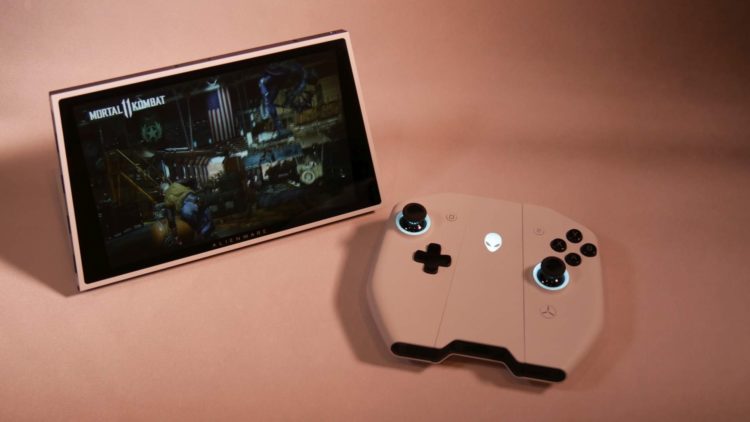Alienware’s PC gaming on the go

Alienware’s Concept UFO impressions: PC gaming on the go
Alienware laptop and desktop systems are fully integrated into the Legendary design aesthetic that was introduced at CES a year ago. The computer maker is ready to give users a glimpse into the future of PC gaming.
That’s where Dell’s Experience and Innovation group comes in. This year, Alienware is presenting a prototype device that could make a marked impact on PC gaming: the Concept UFO. It doesn’t actually fly, but it could take PC gaming to the next level.
This R&D division helps to develop concepts that may become consumer products three to ten years in the future. One of Dell Innovation’s directors of engineering, Kevin Turchin, explained that the emphasis is on portability. People told Alienware that they want to take high-end laptop and desktop gaming experiences everywhere they go, whether it be at a café, at school, or traveling on a bus, train, or airplane. So, it shouldn’t be too much of a surprise that the Concept UFO design bears a rather striking resemblance to the Nintendo Switch.
According to Turchin, the handheld device being shown at CES 2020 has more power packed inside of it than most notebook systems.
What is Alienware’s Concept UFO?

Turchin told PC Invasion that Dell has worked on different versions of Concept UFO for the past two years. The prototype showing at CES is just one iteration, and the final version – if there is one – may use a completely different look or hardware design. The developers were being tight-lipped about its specifications, particularly what type of CPU and GPU was packed inside and how long the battery lasted.
However, Turchin did reveal that the handheld device has an 8-inch touchscreen that supports 1200p resolution. To put that into perspective, the Nintendo Switch has a 6.2-inch 720p screen that delivers impressive gaming experiences. Turchin admitted that, when working with a screen that small, most people can’t tell the difference between 800p and 1200p, so it’s quite possible that the development team may choose to scale back the resolution to boost the graphical fidelity, frame rates, and battery life.
The screen has a thin panel on the back that opens downward to make an “L” shape. Turchin explained that this design helped create a strong foundation without taking up too much room, so it could sit on an airplane tray table without much trouble.
The device also runs the full version of Windows 10, so you could potentially use it as a tiny notebook computer if you wanted to. Technically, the UFO is a laptop shrunk down to a handheld form factor. That means users are free to install any PC game or application onto it, whether it be from Steam, the Epic Games Store, or anywhere else. Therefore, its use is defined by how much its users are willing to put up with on its small screen.
Taking the UFO for a test flight

I got to try out prototype demos that were running Mortal Kombat 11 and F1 2019. Both played shockingly well given how small the device is, and I didn’t experience any stutters or input lag. As someone who has played the Nintendo Switch, I quickly took to the handheld form factor, and I have to say that I very much enjoyed playing Mortal Kombat 11 on it. However, there were a few things I noticed almost immediately.
First, the UFO is considerably heavier than a Switch. Turchin said the prototype weighs around 900 grams, or about 32 ounces. That’s almost 3x heavier than the Switch, so I don’t know what the long-term usage would be like.
Turchin said that the design team put most of its emphasis on ergonomics, which is why they went with a handheld design instead of a tablet or perhaps a redesigned 2-in-1 notebook. “We felt strongly that it didn’t matter how well it performed, how good the screen was, or how long the battery lasted if it didn’t feel right when you picked it up,” he said. “It had to feel like a gaming performance device.”
He added that the design and battery were built for both a two-hour commute and playing at home, where users could plug into a power source. I admit that the UFO felt fine for the short time I spent with it, but there’s no way to know how comfortable it would be after an hour or two without actually experiencing that.
That leads me to the second issue, which is that the left side the UFO I was using, probably where the GPU is located, got very hot. It wasn’t enough to burn me, but it was enough to keep me from wanting to hold it for too long. All the while, I could hear its fans go into overdrive trying to cool it. If the UFO ever does become a consumer device, this could be a major issue.
Lastly, apart from the two USB-C ports that it uses for charging and a headphone jack, the UFO doesn’t have any ports on it for connecting peripherals. It doesn’t even have a microSD slot on it for extra storage and transferring data. The UFO probably has a Bluetooth antenna inside, but it can connect to an existing Dell dock, which enables peripherals such as a mouse and keyboard to be attached along with an external display.
However, Mortal Kombat 11 looked grainy on the 4K monitor the presenters had hooked up to the UFO. So, using the device as a gaming notebook on a high-resolution monitor might be pushing its limits a little too hard.
Things might also get a little dicey when it comes to text scaling on some games on the small screen. Mortal Kombat was fine, but it’s not like they were showing off a text-heavy role-playing game or a game with a lot of menus. But I suppose that would be a relatively minor problem to have.
The point, for now, is that the Concept UFO works, even as an early-stage device. I also found that I really wanted one for myself. It practically stole the show from other devices such as Alienware’s 25-inch gaming monitor and the new AMD Ryzen-based Aurora desktop system.
Looking ahead
The ongoing challenge for the UFO’s development is balancing between power and performance. Generally speaking, PC gamers – especially those who buy Alienware computers – prize performance over all else. However, the math changes a little bit when it shrinks to a handheld form factor. Things such as weight, heat, and battery life become major considerations.

Additionally, Turchin said that the Concept UFO did not yet have the ability to connect directly to other UFOs. Although the development team successfully set up multiplayer matches using UFOs, they could only do so online or by using a router to connect the devices.
Turchin also reminded me that nothing about the UFO’s design is fixed, so the final version could be radically different. Or it might never reach mass production at all.
Even if the latter were the case, the technology that comes from developing the handheld can be applied to a multitude of devices.
Its thermal capabilities are already being used in Dell XPS devices. Other features, such as detachable peripherals, may similarly integrate into other products or become devices on their own.
Check out more Games Guide & Tips Here




